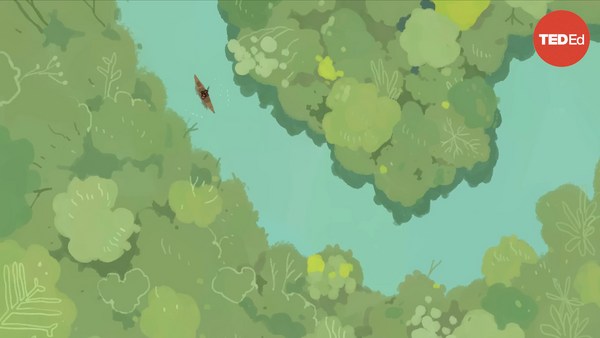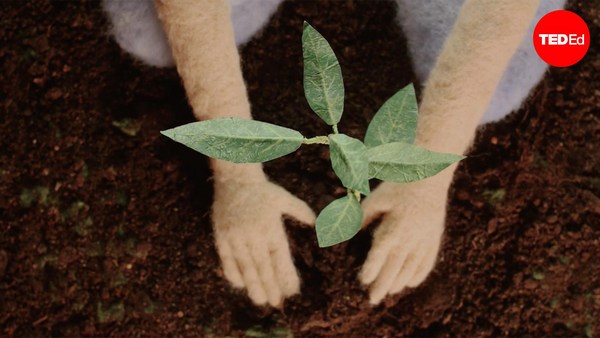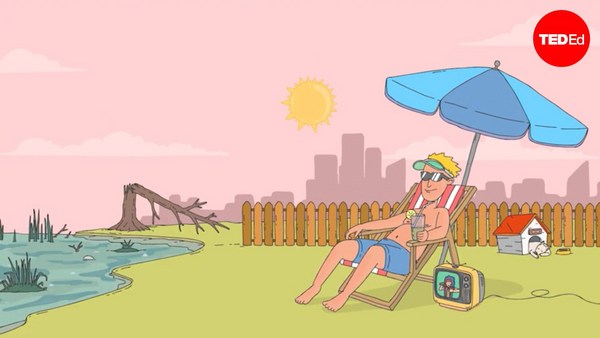You’re traveling down the Amazon when suddenly you spot a flash of pink. It's a male Amazon river dolphin. It's thought that the pinker he is, the more attractive he’ll be to a potential mate. This unique dolphin species is native to the Amazon, and its future is in peril. As of 2022, humans have deforested 17% of the Amazon. And scientists warn that we may be approaching a tipping point— when enough of the forest is lost that large swaths of the ecosystem die. It’s like removing bricks from a house. Take one or two and the house will keep standing. But remove too many and the whole thing will start to cave in.
What happens in the Amazon affects the rest of the planet. To explore this relationship, let’s examine what would happen if the entire Amazon disappeared.
The Amazon is sometimes called Earth's air conditioner. Each day, the Sun beats down on its 390 billion trees. The plants photosynthesize, opening their pores, and losing water to evaporation. This process, known as transpiration, cools both the plant and the surrounding air, and helps form clouds that move over the forest. Through this, the Amazon cycles around 20 trillion liters of water daily.
If the rainforest disappeared, there would be little transpiration to feed the rain clouds. The heat from the Sun would radiate back into the atmosphere, forming chimneys of hot, dry air. The local temperature would increase by several degrees and rainfall in the region would drop. Crops and animals would die as the area— home to 10% of the world’s known species and 30 million people— transforms.
Villages would be stranded as rivers dry up. Dead fish would contaminate the drinking water. Air quality would plummet as wildfires spread. In fact, we’ve already started to see this during recent droughts.
And effects would stretch far beyond the Amazon. Air circulates around the planet, so any change in temperature or pressure in one region can influence currents and winds thousands of kilometers away. These effects are hard to predict. Some models estimate that losing just 40% of the Amazon would reduce rainfall in the agricultural center of Argentina over 3,000 kilometers away. The complete disappearance of the rainforest and its water cycle could cause 50% of the snowpack to melt in the Sierra Nevadas, and a 20% reduction in rainfall in the coastal northwest United States. California’s Central Valley, which grows a quarter of the US’s food, could face dwindling water supplies. We’d lose one of the world’s largest natural carbon sinks. Some scientists estimate that temperatures worldwide would rise an additional 0.25°C above current climate predictions. And while that might sound small, even a slight rise in global temperature can increase severe weather events and habitat loss.
It’s a tragic irony that part of what makes the Amazon so valuable is also the source of its destruction. By some estimates, exploiting the Brazilian Amazon for farming, cattle ranching, and more generates the equivalent of up to 98 billion USD annually. Yet by stopping deforestation and practicing fire management and sustainable agriculture, some researchers predict the region could generate even more wealth than it currently does.
So how close are we to reaching a tipping point? We probably won't know until it's too late. So far, the Amazon has remained resilient. But its very existence relies on transpiration from trees to keep water cycling through it. Removing living trees in one location leaves the surrounding area dehydrated— and more vulnerable to drought and wildfires.
But there are steps we can take today. First, we can choose to buy products from companies that refuse to procure from deforesters. Studies have shown that planting new trees can help restore the forest’s water cycle— though it takes a long time for them to capture as much carbon as an old growth tree. And native stewardship can have a huge impact. There are over 1.5 million Indigenous people living in the Amazon. From 2001 to 2021, portions of the rainforest that weren’t managed by native people emitted 270 million metric tons of carbon to the atmosphere thanks to deforestation and burning. Yet during that same period, portions managed by Indigenous people removed well over 300 million metric tons. The rewards of protecting the Amazon benefit all of us— but the impact of destroying it is already being felt by those living there today.


